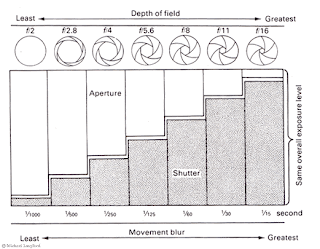Diaphragm:
The diaphragm, located in the lens, is what allows more or less light into the camera, depending on how wide or small the opening is. The numbers on the diaphram go (smallest to largest) 22, 16, 11, 8, 5.6, 4, 2.8,2, 1.4.
The shutter speed is how fast the shutter stays open, dependsing on how much light is entering the camera. The more light there is, the faster the shutter speed. The less light there is, the longer the shutter speed. The slowest speed one can use while using a hand/held camera is one thirtieth of a second. The shutter speeds are 2, 1, 1/2, 1/4, 1/8, 1/15, 1/30, 1/60, 1/125, 1/250, 1/500, 1/1000, and 1/2000.
Depth of field - the longer the lens, the less depth of field and vice versa. This is the contrast between a focused part of the picture and an unfocused part, and the length of space between them in relation to the size of the aperture.
The ISO is the how sensitive the film is to the light. The lower the number, the less sensitive the film is to the light. Also, the lower the number the finer the grain. Higher numbers, such as 1600 ISO, are very sensitive to the light and the grain is much more coarse looking.
The temperature of color is measured in kelvin. Indoor light is 3200 K and outdoor light is 5600 K.
The light meter measures how much light the picture should be taken with, depending on the size of the aperature and the shutter speed.
Claudia Rotondo



No comments:
Post a Comment